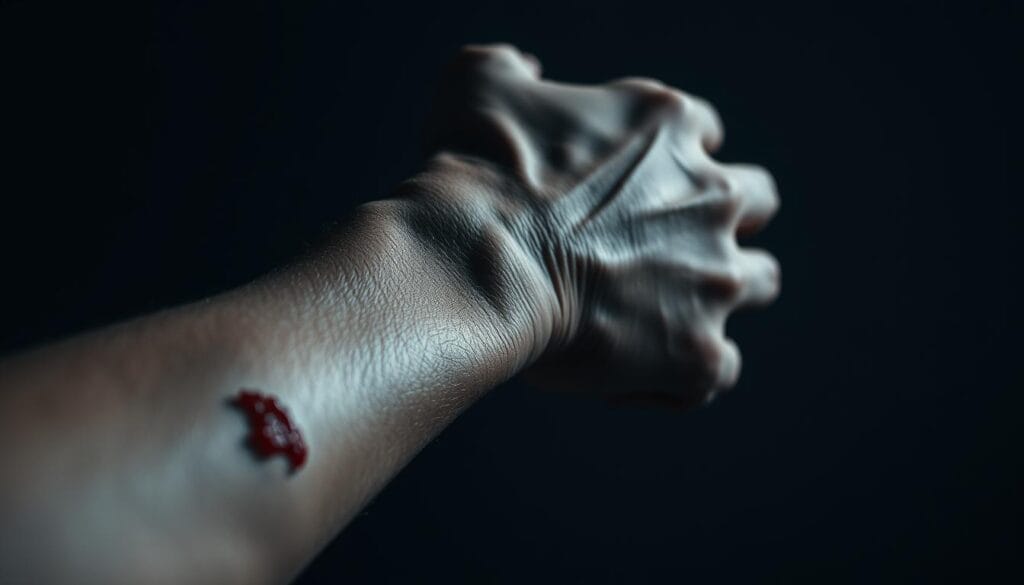self harm treatment options
Self-harm treatment options: Seeking help is the first step towards healing. If you’re struggling with self-destructive behaviors, know you’re not alone. There are effective treatment approaches available.
Types of Emotional Abuse: The Silent Pain That Destroys You from Within
The Mayo Clinic says, “Treatment is based on your specific issues and any related mental health conditions you might have, such as depression.” This means you get care that fits your needs.
Emotional Abuse Checklist You Need to Know
It’s essential to understand your available treatment options. Many therapeutic methods can help you overcome your struggles. They can also improve your mental well-being.
Table of Contents
Self Harm Treatment Options: Understanding Self-Harm
Self-harm, or self-injury, is a complex behavior. It means intentionally hurting oneself as a way to cope with emotional pain.
The Cleveland Clinic says self-harm is “hurting yourself on purpose.” This shows it’s not an accident but a deliberate act.
What is Self-Harm?
Self-harm includes actions like cutting, burning, or hitting oneself. These behaviors can give a temporary relief or sense of control. They are often used when someone feels overwhelmed.
Key aspects of self-harm include:
- Intentionality: Self-harm is a deliberate act, not an accident.
- Emotional coping: It often serves as a maladaptive strategy to manage emotional pain.
- Variety of forms: Self-harm can manifest in different ways, such as cutting or burning.
Common Reasons for Self-Harm
People self-harm for many reasons, including:
| Reason | Description |
|---|---|
| Emotional regulation | Managing overwhelming emotions or stress. |
| Self-punishment | Expressing self-criticism or guilt through physical harm. |
| Sense of control | Regaining a sense of control in chaotic or uncontrollable situations. |
Understanding these reasons is key to finding effective coping strategies for self-harm. It also helps in providing the right support.
By grasping the complexities of self-harm, people can start to tackle the underlying issues. They can work towards recovery with the aid of self-injury therapy.
Signs and Symptoms of Self-Harm
Knowing the signs of self-harm is key to helping those in need. Self-harm, or non-suicidal self-injury (NSSI), can show up in many ways. It’s important to recognize these signs.
Physical Signs to Look For
Physical signs are often the first clue to self-harm. The Mayo Clinic says diagnosis involves a physical and mental check-up. Look out for:
- Unexplained cuts, burns, or bruises
- Scars or fresh injuries
- Broken bones or other injuries that are not fully explained
- Wearing long sleeves or pants, even in hot weather, to hide injuries
Seeing these signs doesn’t always mean someone is self-harming. But they can point to a bigger problem. It’s important to be understanding and sensitive.

Emotional Indicators
Emotional signs are just as important as physical ones. People who self-harm might act differently, like:
- Withdrawal from social activities or friends
- Changes in mood, such as increased irritability or depression
- Difficulty managing emotions or stress
- Low self-esteem or feelings of guilt and shame
These emotional signs can be hard to spot, but catching them early is key. If you’re worried about someone, talk to them openly and without judgment.
Understanding self-harm signs is the first step in helping. By knowing both physical and emotional signs, you can direct them to the right mental health resources.
When to Seek Help
Seeking help is a sign of strength. It can be lifesaving for those dealing with self-harm. If you’re struggling, it’s key to know when to ask for professional help.
Recognizing the Need for Professional Support
The Mayo Clinic says that if self-injury is tied to a mental health issue, treatment targets both. You should look for help if you or someone you know is facing:
- Increased frequency or severity of self-harm
- Difficulty managing emotions or impulses
- Feelings of hopelessness or being overwhelmed
- Social withdrawal or isolation
These signs show that professional support is needed. It helps tackle underlying issues and find better ways to cope.
Understanding Crisis Situations
In crises, quick action is vital. If you or someone you know is at risk of harming themselves, do this:
- Call emergency services or a crisis hotline
- Reach out to a trusted friend or family member for support
- Seek immediate professional help at a hospital or mental health facility
Crises need fast and clear action. Knowing where to get help can greatly improve safety and recovery.
Understanding when to seek help and how to handle crises is a big step towards healing from self-harm. Professional help is out there, and asking for it is a sign of strength.
Types of Self-Harm Treatment Options
Starting your recovery from self-harm means looking at different treatment options. The Mayo Clinic says you might need psychotherapy, medication, or inpatient care. It’s key to find a treatment plan that fits you.
Therapy Approaches
Therapy is a big part of treating self-harm. There are many ways therapy can help you understand and control your actions.
- Cognitive Behavioral Therapy (CBT): Helps you change negative thoughts.
- Dialectical Behavior Therapy (DBT): Teaches you to handle your feelings better.
The American Psychological Association says CBT is great for many mental health issues, including self-harm. This therapy helps you take back control of your life.
Medication Options
Medicine can help with symptoms like depression and anxiety linked to self-harm.
| Medication Type | Purpose |
|---|---|
| Antidepressants | Help with depression symptoms |
| Anti-anxiety medications | Lessen anxiety symptoms |
“Medications can help lessen symptoms of mental health issues that lead to self-harm.”
Support Groups and Community Resources
Support groups are places where you can share your story and get support from others who get it.
Being in a support group is a big step towards healing. It gives you a sense of belonging and understanding. You can find groups through local mental health groups or online.
Healing from self-harm needs a full treatment plan. This includes therapy, medication, and support. By looking into these options, you can find the best way to heal.
Cognitive Behavioral Therapy (CBT)
For those dealing with self-harm, Cognitive Behavioral Therapy (CBT) is a helpful path to healing. It helps you change negative thoughts and actions into positive ones. This makes it easier to cope with tough times.
How CBT Works for Self-Harm
CBT shows that your thoughts, feelings, and actions are linked. By changing this cycle, you learn better ways to handle problems. The Mayo Clinic says CBT helps you swap bad beliefs and actions for better ones.
- Identifying distorted or negative thought patterns
- Challenging these thoughts through evidence-based techniques
- Learning new skills to manage emotions and behaviors
CBT is a team effort between you and your therapist. It’s designed just for you. It helps you take back control of your life and make good changes.
Effectiveness of CBT
Many studies show CBT works well for self-harm. It tackles the root causes and teaches better ways to handle feelings and actions. This makes CBT a strong choice for self-injury therapy.
CBT’s method and goal of empowering you make it key in treating self harm. Adding CBT to your treatment plan gives you the tools to beat self harm and boost your mental health.
Dialectical Behavior Therapy (DBT)
Dialectical Behavior Therapy (DBT) is a helpful approach for those dealing with self-harm. It was created by Marsha Linehan. DBT mixes cognitive-behavioral methods with skills in dealing with distress, acceptance, and being mindful.
Principles of DBT
DBT is based on important principles to manage emotions and cut down on self-harm. These include:
- Mindfulness: Being fully present and aware in the moment, without judgment.
- Distress Tolerance: Techniques to tolerate pain without resorting to self harm.
- Emotional Regulation: Understanding and managing emotions to reduce intensity.
- Interpersonal Effectiveness: Skills to communicate effectively and maintain healthy relationships.
Learning these skills helps people deal with tough situations better. It also reduces their need to harm themselves as a way to cope.

DBT’s Role in Self-Harm Recovery
DBT is key in helping people recover from self harm. It gives them the tools to handle their emotions and actions better. The therapy works well because it tackles self harm in a detailed way.
DBT helps in several ways:
- Teaching new ways to cope instead of self-harm.
- Improving emotional control to lessen feelings that lead to self-harm.
- Boosting skills for better relationships and less conflict.
By working on these areas, DBT helps people live a more stable and rewarding life. It reduces their need to harm themselves.
Medication Options for Self-Harm
Medication isn’t a direct fix for self-harm. It helps with the mental health issues that might lead to it. The Mayo Clinic says meds can treat depression, anxiety, or mood disorders.
Types of Medications
There are several meds for the mental health issues linked to self-harm. These include:
- Antidepressants: SSRIs are often used for depression and anxiety.
- Mood Stabilizers: Lithium helps with mood swings, especially in bipolar disorder.
- Anti-anxiety Medications: Benzodiazepines offer quick relief for severe anxiety, but are used with caution due to dependency risks.
Pros and Cons of Medication
Medication can help manage the mental health issues that lead to self-harm. The good points are:
- Symptom Reduction: Medications can lessen symptoms of depression, anxiety, and other conditions.
- Improved Mental Health Stability: They can stabilize their mood and help cope with mental health issues better.
But, there are also downsides:
- Side Effects: Many meds have side effects, from mild to severe.
- Dependency Risk: Some meds, like benzodiazepines, can lead to dependency if not used correctly.
It’s key for people to work closely with their doctor. They need to find the right medication and dosage. They also need to keep an eye on how it’s working and make changes as needed.
Support Groups and Peer Support
Support groups are a safe place to share your experiences and learn from others. They are key in your self harm recovery journey. You’ll find a sense of community and understanding here.
Finding the Right Support Group
Think about what you want to get from a support group. You might look for groups focused on self harm or general mental health. Samaritans and CALM offer confidential support, a great place to start.
Here are some tips for finding the right group:
- Ask your therapist or healthcare provider for suggestions
- Look online for groups in your area or virtual options
- Contact local mental health organizations for more information
Benefits of Peer Support
Peer support is incredibly powerful in recovery. It offers a deep understanding and connection that’s hard to find elsewhere. By sharing your story and hearing others, you gain new insights and feel less alone.
Peer support offers many benefits:
- Understanding and empathy from those who’ve been through similar things
- A chance to share your story and help others
- A community that truly gets the challenges of self-harm recovery
As you move forward in your recovery, think about the role of support groups and peer support. Connecting with others who understand your struggles can be a big step forward.

Holistic and Alternative Treatments
Alternative therapies can be a good addition to traditional self harm treatments. They focus on the whole person – body, mind, and spirit. This approach aims to heal and improve well-being.
Mindfulness and Meditation
Mindfulness and meditation help reduce stress, anxiety, and depression. The Mayo Clinic says they’re great for managing anxiety and depression. These are common reasons for self-harm.
By practicing mindfulness, you can stay present and handle negative emotions better. It’s about being aware of your thoughts and feelings.
Mindfulness techniques include deep breathing, body scan meditation, and mindful walking. These help you understand your emotions better. It makes it easier to resist self harming urges.
Art and Music Therapy
Art and music therapy are creative ways to express feelings linked to self-harm. They offer a healthy way to deal with negative thoughts and emotions. These therapies help in self-expression and healing.
Art therapy uses art, like drawing, painting, or sculpting, to express emotions. Music therapy involves music creation, singing, or listening to heal emotionally. Both can be customized to fit your needs.
Adding holistic and alternative treatments to your plan can help manage self harm better. It promotes overall well-being.
Developing Coping Strategies
To manage self harm, it’s key to find coping strategies that fit you. The Mayo Clinic suggests knowing what might make you want to harm yourself. Then, plan other ways to calm down or distract yourself.
Creating a Personalized Coping Plan
Creating a plan means spotting your triggers and finding new ways to deal with them. Try mindfulness techniques like meditation or deep breathing. Also, do things you love, like hobbies or hanging out with friends.
Keeping a journal can also help. Write down when you feel like self-harming and what happened before. This can show you patterns and help you find ways to handle them.
Long-Term Strategy for Managing Urges
For long-term management, mix short-term coping methods with ongoing therapy or support. Dialectical Behavior Therapy (DBT) and Cognitive Behavioral Therapy (CBT) are great for this.
Also, having a support network of friends, family, or groups is crucial. It gives you a sense of belonging and helps you stay focused on recovery. Remember, recovery is a journey, and a strong support system can greatly help.
By using effective coping strategies and staying committed to recovery, you can manage self-harming urges. This will improve your overall well-being.
Moving Forward: Recovery and Hope
Recovery from self-harm is a journey that needs patience, understanding, and the right support. You can start healing by looking into different self-harm treatment options.
Pathways to Recovery
Setting realistic goals is key in your recovery journey. This means finding out what triggers you, learning new coping strategies, and getting help for mental health. The Cleveland Clinic says getting help for self-harm is a big step towards feeling better physically and mentally.
Maintaining Long-Term Well-being
Keeping well in the long run means getting ongoing support and taking care of yourself. Joining support groups, practicing mindfulness, and using therapy like CBT and DBT can help. By using these resources and sticking to your recovery plan, you can keep moving forward.
By following these steps, you can move forward with hope and confidence. You’ll know that there are effective self-harm treatment options to help you on your way to a healthier, more fulfilling life.







